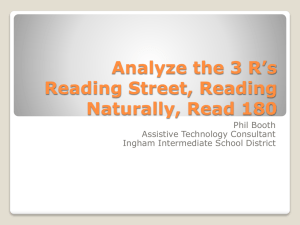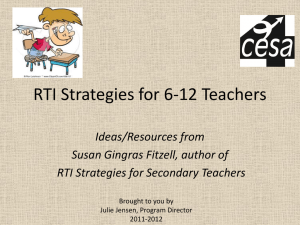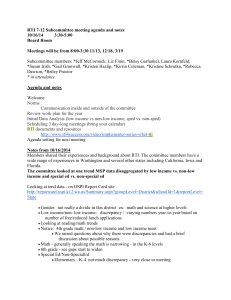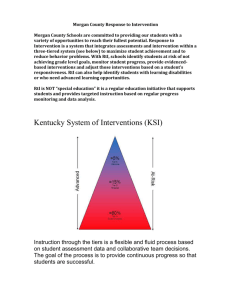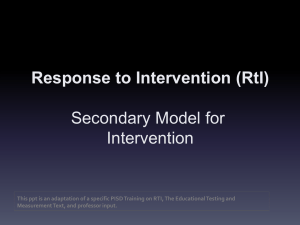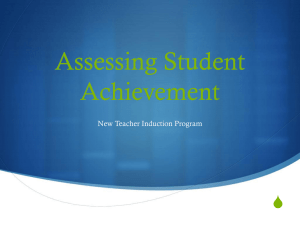File - Craig Bryant
advertisement
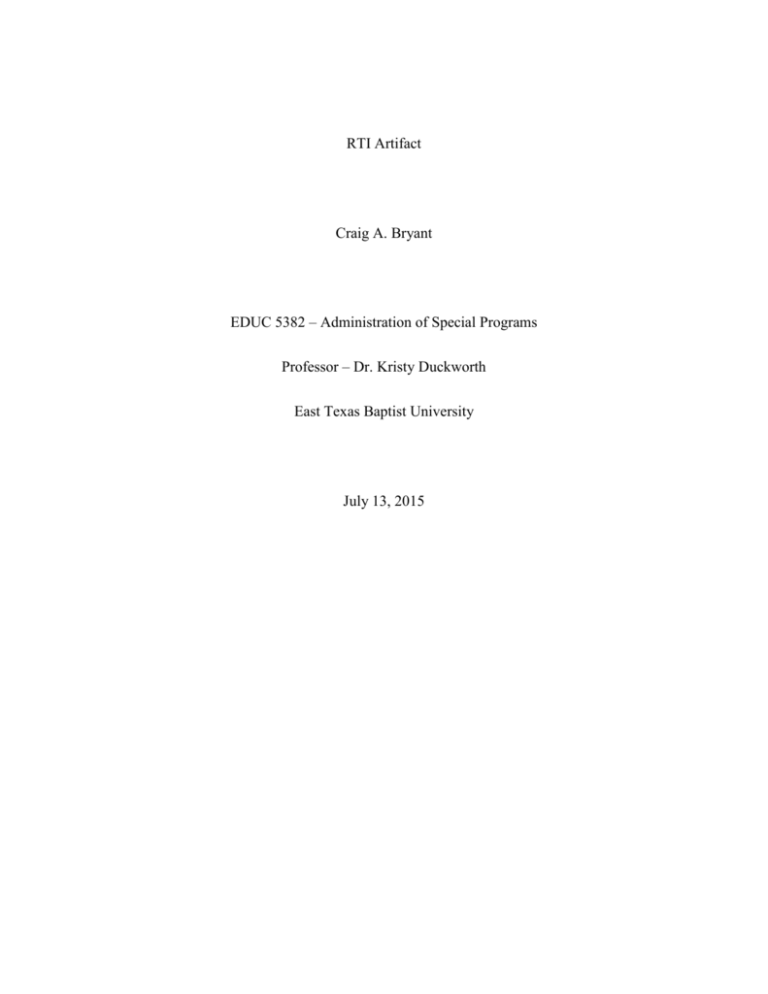
RTI Artifact Craig A. Bryant EDUC 5382 – Administration of Special Programs Professor – Dr. Kristy Duckworth East Texas Baptist University July 13, 2015 TEA RtI may be described as a model addressing the needs of all students through a continuum of services which provide: (1) high-quality instruction and scientific, researched-based, tiered intervention strategies aligned with individual student need; (2) frequent monitoring of student progress to make results-based academic or behavioral decisions; (3) data-based school improvement; and (4) the application of student response data to important educational decisions (such as those regarding placement, intervention, curriculum, and instructional goals and methodologies). The activities described above typically occur in the general education setting as schools assist struggling students. Local education agency (LEA) staff coordinate and collaborate in developing a process implementing this framework. More information concerning RtI activities can be accessed through the TEA Division of Curriculum. Students who are suspected of having a disability should be referred for a full and individual evaluation. States and LEAs have an obligation and requirement under federal law (34 CFR § 300.111 Child Find) to ensure that evaluations of children suspected of having a disability are not delayed or denied because of implementation of an RtI strategy. Clarification of this issue has been provided from the Office of Special Education Programs (OSEP). Frequently Asked Questions Is my campus required to implement response to intervention (RTI)? Is it the law? For how long can a student receive intervention before being referred for a special education evaluation? What is the difference between Tier II and Tier III? Do students participate in all three tiers at the same time? In how many tiers can a student participate? Is differentiated instruction the same as intervention? When a student in foster care withdraws from school, am I required to provide information about the intervention s/he received for the Texas Department of Family and Protective Services education folder or for the receiving school? Is my campus required to implement response to intervention (RTI)? Is it the law? Texas school districts and charter schools are not required to implement RTI—rather, they have the option of doing so. This question presents an opportunity to clarify sources of requirements related to RTI. In general education, RTI is implemented as an instructional approach designed to prevent learning and behavior difficulties. Schools that implement RTI screen all students to identify those who are at risk and not meeting grade-level expectations. These at-risk students are immediately assigned to a level, or tier, of additional intervention instruction to close their gaps in learning, and their progress is monitored to make sure the intervention is working. Interventionists document the students’ response to the intervention over time. Increasingly intense levels of intervention are provided when needed. In Texas, school districts and charter schools determine their instructional approaches through policies and procedures. Thus, RTI is not a state-mandated instructional approach, although it may be required through school district or charter school policies and procedures. RTI appears in federal special education law related to the identification of students with specific learning disabilities. The Individuals with Disabilities Education Improvement Act of 2004 (IDEA 2004) identifies RTI as an optional component of a comprehensive evaluation and requires that states “(2) must permit the use of a process based on the child’s response to scientific, research- based intervention; and (3) may permit the use of other alternative research-based procedures for determining whether a child has a specific learning disability” [34 CFR §300.307 (2-3)]. The Texas Education Code mirrors the language of IDEA and leaves it to school districts and charter schools to determine policies and procedures related to individual comprehensive evaluation, including the use of information related to a student’s response to intervention. Texas school districts and charter schools may opt to include documentation of a student’s response to intervention as a component of a comprehensive evaluation. back to top For how long can a student receive intervention before being referred for a special education evaluation? A student should be referred as soon as a disability is suspected, including when progressmonitoring data indicate that the student is not responding adequately to intervention. Some educators mistakenly believe that in schools where RTI is being implemented, students must be provided with interventions prior to referral for a full and individual initial evaluation and that participation in RTI is a prerequisite for conducting an initial evaluation. A student may participate in interventions while undergoing the initial evaluation process. Although data from the student’s response to the intervention provide the committee valuable information to determine the presence of a specific learning disability, the comprehensive initial evaluation process cannot be delayed until the student has been provided with intervention for a specified period. The US Department of Education addresses this topic in Memorandum 11-07 and explicitly refers to Texas in its February 29, 2012, letter to Philip Ferrara, writing that “…the implementation of an RTI process cannot be used to delay or deny the full and individual evaluation of a child suspected of having a disability…whether the disability is suspected by school personnel or the child’s parent.” Note: Memorandum 11-07 and the letter are included in A Resource for Student Evaluation Personnel Working in Schools Implementing Response to Intervention (RtI). back to top What is the difference between Tier II and Tier III? Do students participate in all three tiers at the same time? In how many tiers can a student participate? RTI is a multitiered system of support that provides high-quality research-based instruction to all students in the general education setting (Tier I) and additional intervention instruction for at-risk students. Many schools implement a three-tiered RTI framework, which provides at-risk students with increasingly intense interventions (Tier II or Tier III) to close their gaps in learning. Teachers in each grade level use student assessment data to determine criteria for each tier of intervention and then match each at-risk student to the tier designed to meet his or her needs. The size of a student’s learning gap determines the tier of intervention received: The larger the learning gap, the more intense the intervention. Intervention is designed to systematically address gaps in a student’s fundamental knowledge and skills; intervention is not reteaching. Ideally, Tier II intervention is provided in groups of three to five students with similar needs for an additional 30 minutes daily. Depending on a school’s RTI framework, a teacher or a specialist may provide Tier II intervention. Tier III is more intense and is provided in smaller groups of one to three students for at least an additional 30 minutes a day. A specialist provides Tier III intervention. An at-risk student receives Tier I instruction, plus either Tier II or Tier III intervention. back to top Is differentiated instruction the same as intervention? Differentiated instruction is not the same as intervention instruction—rather, it is a critical component of both content area instruction and intervention. Effective teachers use their knowledge of students’ skills to differentiate instruction. In the video “Understanding Differentiated Instruction“, Dr. Sharon Vaughn states ”…one example at the whole class level is that teachers actually know to differentiate the expected response for students based on the range of knowledge and expertise of the class.” Teachers consider students’ needs and adjust instructional materials, grouping, required responses, scaffolding, and practice time in their lessons. Teachers who differentiate instruction have high levels of student attention and engagement and adjust their expectations to yield the greatest performance outcomes from their students. Differentiated instruction should be provided across all tiers, as it benefits all students. back to top When a student in foster care withdraws from school, am I required to provide information about the intervention s/he received for the Texas Department of Family and Protective Services education folder or for the receiving school? Students in the foster care system often experience delays in making educational progress due to frequent changes in placement and schools. In the spirit of facilitating this transition, provide documentation of intervention strategies tried, the student’s response to intervention instruction, and progress-monitoring data, so the next school has information to make instructional decisions. Providing this information helps to minimize the amount of instructional time lost while trying to match intervention programs to the student’s instructional needs. Providing this information to the student’s caregiver or caseworker goes beyond minimal requirements and helps other educators meet the student’s needs. Funding Sources for Response to Intervention Programs Federal Guidance | Required Use of CEIS (Significant Disproportionality) | RTI/CEIS PowerPoint Presentation | Questions & Answers For a general education student who has not been found eligible under special education, a local education agency (LEA) may use a variety of funding sources to provide supplemental services or instruction based on the student's response to scientific, research-based intervention. Potential funding sources include Title I, Part A funds and coordinated early intervening services funds. IDEA-B Coordinated Early Intervening Services Funds Coordinated Early Intervening Services (CEIS) Guidance Use of Coordinated Early Intervening Services Funds for Supplemental Services or Instruction based on Response to Intervention (RtI): RtI may be described as a model addressing the needs of all students through a continuum of services which provide: 1. high-quality instruction and scientific, researched-based, tiered intervention strategies aligned with individual student need; 2. frequent monitoring of student progress to make results-based academic or behavioral decisions; 3. data-based school improvement; and 4. the application of student response data to important educational decisions (such as those regarding placement, intervention, curriculum, and instructional goals and methodologies). These activities typically occur in the general education setting as schools assist struggling students prior to and in lieu of a referral to special education. LEA general and special education staff will need to coordinate and collaborate in developing a process implementing this framework. CEIS funds may be used to carry out RtI activities that are coordinated with and aligned to activities funded by the Elementary and Secondary Education Act of 1965 (ESEA), including scientifically based literacy instruction such as “Reading First”, if those funds are used to supplement, and not supplant, these activities [see 34 CFR §300.226(e)]. Use of CEIS funds may include the incorporation of interagency financing structures in carrying out RtI-related activities. CEIS-funded activities involving RtI may include, but are not limited to, the following: Professional Development: Training of district personnel on the use of RtI in evaluation and eligibility determination of specific learning disabilities Training on the establishment and implementation of local education programs using the RtI model Training on research-based, academic and behavior supports for struggling students Evaluation: Implementation of RtI student progress monitoring RtI student progress monitoring tracking systems Implementation of school-wide RtI-related behavior intervention monitoring systems Services and Supports: Tiered instructional systems based on student progress monitoring Tiered behavioral supports based on student progress monitoring School-wide student assistance systems The U.S. Department of Education, Office of Special Education Programs (OSEP) provides resources, including a topic brief, a video clip, training materials, a dialogue guide, presentations and a Q&A document regarding both EIS and RtI. Title I, Part A Funds: Title I, Part A funds must be expended for programs/activities/strategies that are scientifically-based on research and meet needs (identified in the campus’ comprehensive needs assessment process) which are listed in the campus’ improvement plan. School-wide Programs—On school-wide program campuses, the LEA may use Title I, Part A funds for activities that are part of the Campus Improvement Plan to improve student performance and upgrade the entire educational program. In a school-wide program, the amount of Title I, Part A funding on the campus must be supplemental. Targeted Assistance Programs—In targeted assistance schools, the LEA may only use Title I, Part A funds to meet the needs of children identified as being in the greatest need of services. Students must be selected using multiple, educationally-related, objective criteria established by the LEA. In a targeted assistance program, the program/activity/strategy must be supplemental. Regardless of which type(s) of Title I, Part A program the LEA operates, it is possible that preventive speech services may be allowable if the LEA is able to respond appropriately to, and maintain documentation for, each of the following questions to determine whether an expenditure would be allowable: 1. Is the expenditure reasonable and necessary to carry out the intent and purpose of the program? 2. Does the expenditure address a need previously identified in the campus comprehensive needs assessment? 3. Is the program/activity/strategy to be funded described in the campus/district improvement plan prior to the question to pay the expenditure from Title I, Part A funds? 4. How will the expenditure be evaluated to measure a positive impact on student achievement? 5. If a school-wide campus, will the expenditure upgrade the entire educational program on the campus? 6. Is the expenditure supplemental to other non-federal programs? On a schoolwide program, the amount of Title I, Part A funding on the campus must be supplemental. On a targeted assistance program, the program/activity/strategy must be supplemental.
